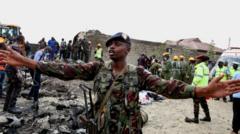What Led to the Deadly Small Plane Crash in Kenya That Killed Six?

Tragic Aircraft Crash in Nairobi: Understanding the Impact and Circumstances
In a heartbreaking incident that has shaken the community, a light aircraft belonging to the medical charity AMREF Flying Doctors crashed in Nairobi, resulting in the tragic loss of six lives. The aircraft, a Cessna, took off from Wilson Airport on a mission to Hargeisa, Somalia, when it lost contact with air traffic control just three minutes after takeoff. This article delves into the details of the accident, the response from emergency services, and the broader implications for aviation safety in the region.
The Incident: A Sequence of Events
The fateful flight took off on a Thursday afternoon, filled with medical personnel, including doctors and nurses, who were dedicated to providing essential healthcare services. Unfortunately, the aircraft encountered trouble shortly after takeoff, losing both radio and radar contact with air traffic control. This alarming situation led to a crash in the densely populated Githurai area, where the plane ignited upon impact with a residential building.
Eyewitness accounts provide a harrowing perspective on the crash. Patricia Kombo, a local resident, described the moment she heard a loud bang and saw a red flash, followed by thick smoke billowing into the sky. The chaos that ensued included people screaming and running in panic, highlighting the immediate danger and fear that enveloped the area.
Casualties and Immediate Response
The aftermath of the crash revealed that six individuals on board the aircraft lost their lives, along with two people on the ground. The crew comprised four members, including AMREF staff, who were on a mission to provide critical medical services. The presence of both the Kenya Defence Forces and the National Police Service underscores the seriousness of the situation, as search and recovery operations were swiftly initiated.
AMREF's CEO, Stephen Gitau, expressed condolences and emphasized the organization's commitment to cooperating fully with aviation authorities to uncover the facts surrounding the tragic event. The swift response from emergency services was crucial in managing the immediate aftermath of the crash, providing care for the injured, and securing the site for further investigation.
Investigating the Causes: What We Know So Far
As investigators arrive at the crash site to determine the cause, several critical factors need to be examined. The loss of radio and radar contact just minutes after takeoff raises questions about the aircraft's mechanical integrity and adherence to safety protocols. The Kenya Civil Aviation Authority has taken the lead in this investigation, highlighting the importance of understanding what went wrong to prevent future tragedies.
The Role of AMREF Flying Doctors
AMREF Flying Doctors plays a pivotal role in providing medical assistance across East Africa. Their fleet of aircraft is essential for transporting healthcare professionals to remote areas, facilitating medical evacuations, and responding to emergencies. The loss of personnel in this crash represents not only a personal tragedy for families and friends but also a significant setback for healthcare delivery in the region.
In response to the crash, AMREF is likely to review its operational protocols and aircraft safety measures rigorously. This incident emphasizes the necessity for stringent safety regulations and regular maintenance checks to ensure the aircraft is fit for the demanding tasks they undertake.
The Broader Context: Aviation Safety in Kenya
This tragic incident highlights broader concerns regarding aviation safety in Kenya. While air travel is an essential component of connectivity and emergency response in the region, the frequency of aircraft incidents raises critical questions about regulatory oversight and safety standards. Recent years have seen several aviation mishaps, prompting calls for enhanced safety measures and better training for aviation personnel.
Key Factors Affecting Aviation Safety
Several factors contribute to the safety of aviation operations, including:
- Regulatory Compliance: Adherence to international aviation standards is vital for ensuring safety. Authorities must enforce regulations effectively.
- Training and Certification: Pilots and crew members need rigorous training and regular evaluations to maintain high competency levels.
- Aircraft Maintenance: Regular inspections and maintenance checks are crucial for ensuring that aircraft remain operationally sound.
- Weather Conditions: Pilots must be trained to assess and respond to changing weather conditions that can affect flight safety.
Community Impact and Support
The immediate community affected by the crash has understandably been shaken by the incident. With the loss of life and damage to property, local authorities will likely initiate support measures for the victims' families and those impacted by the crash. Mental health resources may be necessary to help individuals process the trauma of witnessing such a catastrophic event.
The Role of Local Organizations
Local organizations, including community groups and non-profits, may step in to provide support and assistance to those in need. This can include counseling services, financial assistance for families affected by the tragedy, and community forums to discuss recovery efforts. The resilience of the community will be tested, but collective support can foster healing in the aftermath of such a disaster.
Conclusion: Reflecting on the Tragedy
The crash of the AMREF Flying Doctors’ aircraft is a tragic reminder of the risks associated with aviation, especially in regions where air travel is a lifeline for medical services. As investigators work to uncover the causes of this incident, it is essential for stakeholders in the aviation industry to prioritize safety and implement necessary changes to prevent future tragedies. The loss of dedicated healthcare professionals in the crash serves as a stark reminder of their vital role in society, and the impact of this incident will be felt for years to come.
As we reflect on this tragic event, it raises important questions about how we can improve aviation safety and support communities affected by such disasters. What measures do you think should be implemented to ensure the safety of flights in the region? #AviationSafety #Kenya #AMREF
FAQs
What led to the crash of the AMREF Flying Doctors aircraft?
The aircraft lost both radio and radar contact with air traffic control just three minutes after takeoff, leading to the crash in a residential area of Nairobi.
How many people were involved in the crash?
Six people on board the aircraft were killed, including doctors, nurses, and the pilot. Additionally, two people on the ground lost their lives, and two others were seriously injured.
What is AMREF Flying Doctors?
AMREF Flying Doctors is a medical charity that operates aircraft to provide healthcare services, including emergency medical evacuations and transporting healthcare professionals to remote areas in East Africa.
What actions are being taken in response to the crash?
A thorough investigation is underway to determine the cause of the crash. AMREF is cooperating with relevant aviation authorities, and local emergency services have been deployed for search and recovery operations.
```Published: 2025-08-07 17:36:09 | Category: world



